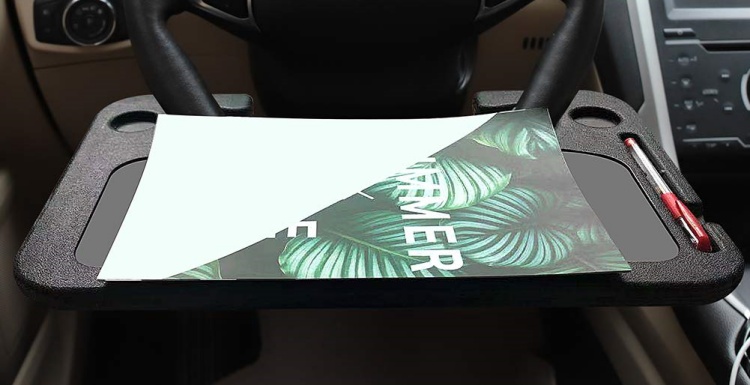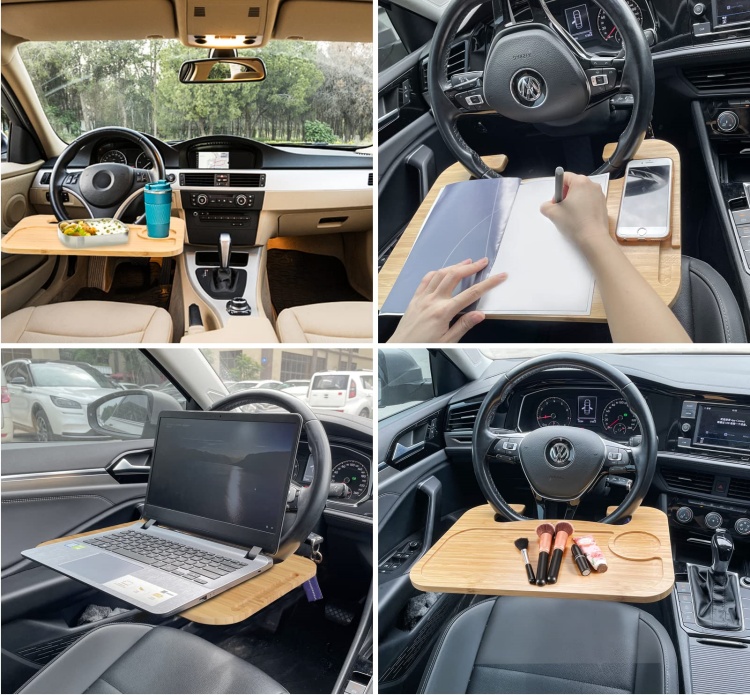
Steering Wheel Desk Accessories You Didn’t Know You Needed
If you spend a lot of time driving for work or even just long commutes, having a portable desk set up in your car can

Steering wheel desks provide a convenient surface for working while commuting or waiting in your vehicle.
However, without proper adjustment and good posture habits, you can still experience neck, shoulder and back pain. This comprehensive guide covers smart ergonomic practices when installing and using a steering wheel workspace. Follow these tips to create a comfortable in-car office!

Assess your space by evaluating the dashboard and floor room, optimizing seat positioning, considering airbag safety, accommodating movement, and ensuring protection from extreme temperatures.
Take measurements of the space between your steering wheel and legs/dashboard area. This allows clearance for installing clamps and ensures you can fully turn the wheel once the desk is in place without obstruction. Also, check protrusions on the floor around pedals or gears that could block legroom when pulled fully forward in the seat.
The ideal viewing angle over your steering wheel desk is slightly downward with your back fully supported by the vehicle seat. Adjust your seat height to achieve sightlines angled 15-30 degrees downward to the work surface. Make sure at your highest seating capacity that you still have 1.5 – 2 inches between the top of your head and the interior roof so as not to bump around.
Avoid attaching any steering wheel accessory directly over the center expansion zone for airbag deployment. Secure clips on the 9 o’clock and 3 o’clock positions instead. Also, check your vehicle manual regarding appropriate gear attachments related to safety features as part of your initial evaluation.
Your in-car office will be in motion, so accounting for normal driving vibration and bumps is key. Install padding, grips, guards and adjustable clips to prevent items from slipping or rattling around at highway speeds. Stow smaller loose supplies in secure compartments. Window glare, swerving turns and hard braking can also impact your ability to focus, so choose a low-profile setup.
Consider when and where you will primarily drive while using this desk. Prolonged sun exposure can damage devices and make surfaces dangerously hot. Your steering wheel itself could burn skin without insulation layers! The opposite applies to extremely cold climates. Position items sensitive to temperature fluctuation away from heating/cooling vents and direct windows.
Choose supportive seating by ensuring lumbar reinforcement, providing coccyx relief, and properly adjusting the headrest for optimal comfort and posture.
Lumbar reinforcement:
— Poor posture leads to back strain over time, so center console supports and small pillows can provide helpful lumbar reinforcement. Or use a backrest with built-in adjustable lumbar pads. These aids improve spinal alignment when sitting upright. Look for cushioning with both firm and soft elements to evenly distribute weight.
Coccyx Relief:
— Sitting puts pressure on your tailbone area which can get quite uncomfortable, especially if driving over bumpy roads. Seat cushions with section cutouts or gels that suspend your sit bones can help eliminate painful pressure points. This also encourages maintaining good posture versus slouching from discomfort.
Adjust the headrest properly:
— Your vehicle headrest should be positioned to fill the gap between the top edges of your seat and the bottom of your skull. Having proper height alignment here prevents whiplash. But take care that it is not so far forward that it pushes you into a chin-to-chest hunched position, which adds neck tension.

Check sightlines and reach by implementing glare reduction, ensuring easy access to essential items, and minimizing twisting motions for ergonomic safety.
Glare reduction:
Position your steering wheel desk so that the middle eye level focuses just above the front edge. This sightline angle prevents having to crane down constantly to see your work. If driving at night or through variable lighting conditions, use auto-dimming low-glare film overlays to reduce eye fatigue and enhance work surface visibility.
Easy access:
Place the items/devices you need to interface with most regularly closest and centered about the steering wheel. Having frequently used items on awkward side angles outside your natural reach adds unnecessary strain. Your primary screen and keyboard should align comfortably with your wheel hand positions at 9 and 3 o’clock.
Reduction of twisting motions:
Avoid the need to over-rotate your torso or neck to one side or the other frequently throughout your workspace. As best possible, segment needed items to both left and right access zones around the wheel. You can glance side to side without over-extending muscles if the majority of twisting strain is minimized.
Maintain proper angles for wrists, hands, head, neck, elbows, shoulders, hips, knees, and ankles to prevent strain and enhance ergonomics.
Wrists and hands: Keeping wrists extended with straight anatomical angles reduces the risk of repetitive stress injuries like carpal tunnel syndrome. Split keyboards allow for optimal left/right wrist alignment. Or a central drawer pull-out keyboard/mouse platform under the main desktop extends everything forward into a straighter typing angle.
Head/Neck: The standard recommendation for looking downward at a screen is between 15 to 30 degrees below your normal forward-looking eye level. Installing your steering wheel desk higher up allows the fixed sightlines to fall within this range without constant neck flexing. You can accomplish this angle by raising your seat height while attaching the desktop surface lower on your steering wheel arc.
Elbows and shoulders: Proper elbow alignment also minimizes discomfort in your neck and back resulting from hunched shoulders or overextended reaches. Your steering wheel desk should have sufficient depth front to back for you to rest your forearms while keeping your upper arms hanging and relaxed on both sides rather than extended forward or out wide.
Hips, knees and ankles: Adequate clearance space between your abdomen and the bottom edge of the steering wheel desk prevents compression along the thighs. Having to strain leg joints extended for too long can pinch nerves or reduce blood circulation. Bend knees at 90-degree angles as able, and keep items from crowding pedal access. Propping feet up on lower dashboard edges or inserts can take pressure off the spine.
Take microbreaks to blink and refocus, engage in light stretching, change positions regularly, and stay hydrated for sustained well-being.
Every 20 minutes, follow the 20/20/20 rule by taking 20 seconds to close your eyes and breathe deeply while looking out 20 feet in front of you. This eye break and mental refocusing are essential if your tasks require prolonged screen staring. Combining periodic blinking with long-distance refixation reduces digital eye fatigue.
Simple neck rolls with your head turning gently right to left and shoulder rotations encourage circulation and relieve tension. Just avoid overextending motions and any sudden jerking!
You can alternate shoulder rolls front to back or even gently press elbows backward to open up the chest. Deep full torso twists are not advisable while a seatbelt is fastened across your body.
Every hour to 90 minutes, take a short break to walk around the rest area, swap which leg is dominantly crossed on top, or switch sitting upright versus leaning back against the adjustable seat. Varying spinal orientation and release points prevent strain from staying fixed too long.
Dehydration causes headaches, loss of concentration and fatigue which worsens discomfort. Keep your chosen non-spill drinking container mounted within easy reach. Hydrating swallows every 15-30 minutes improves cognition and overall wellness. Adjust your restraints so they are firm but not constricting against breathing zones.
Pay attention to any sensations of tingling, numbness or shooting pain as warning signs to take a break and reassess your positioning. Nerve compression causes lasting damage if you try to push through excruciating carpal tunnel or sciatic pain. Refrain from overexertion and stop working if discomfort persists despite rest breaks and postural adjustments.

Now that you know how to assess your spaces and ergonomic factors, explore options for creating the optimal steering wheel desk setup tailored to your needs and preferences:
Basic wheel trays:
The most affordable and straightforward option is a simple wheel tray that sits flush against the wheel. Low-profile edges keep them from hitting your legs or the dash as you turn. An anti-slip surface holds items securely. These minimalist trays still offer ample usable space for smaller devices or a notebook and pen without complex installations.
Adjustable clips and mounts:
Height, width and angle customizable clips allow tweaking the exact placement of your desktop surface on the wheel arc for individual comfort. Rotating phone and tablet mounts with long arms also position devices ergonomically while keeping them secure. Extenders projecting over legs increase useable square footage.
Cushions and supports:
Portable cushions with cut-outs or gels provide coccyx and lumbar relief while on the road. They prevent slouching and evenly distribute weight. Inflatable pillows allow adjusting firmness. Some even have massage features! Travel neck supports wrap around the base of your skull to prevent dangerous head drops while keeping the chest open.
Cupholder and storage accessories:
From secured holsters and slots for phones/writing instruments to trays for papers or notebooks, organized proximity storage is essential. The best steering wheel desks integrate smart compartments for quick access to all the little items you need while working. Mounted cupholders allow hydrating without risky spills.
Portable power:
Low battery anxiety sabotages productivity, so keep charged on the go! Mounted power strips/USB hubs distribute charging cords to devices. External batteries can recharge phones multiple times without needing to plug into car outlets. Wireless charging pads mean simply setting your phone down to restore juice.
Blue light-blockers and screen covers:
Protect your eyesight while you work with innovative screen cover overlays to filter intense glare and blue emissions. These films have specially engineered properties to guard against factors causing digital eye strain plus enhanced privacy. Auto-darkening versions toggle transparency.
Full workstations:
On the premium end, you can find complete modular station set-ups. They clip onto your wheel and may extend out with side tables. These desks allow for mounting larger monitors and full-sized keyboards for intensive computing. You can truly equip your vehicle like a mobile office with high-capability electronics!

Despite the optimizations possible, using a steering wheel desk has inherent challenges compared to a stable home setup. Safety remains imperative when engaging in activities inside a moving ton of metal!
Eyes up!
— Never attempt to type lengthy documents or read e-books while actively operating a moving vehicle. Glancing down occasionally at maps or playlist selections is the full extent of acceptable “screen time” for drivers. Dictate text messages and emails verbally via hands-free systems only.
Pullover
— If you need to send important communications, enter complex data or read dense information, pull over completely off the road first! Find a safe parking area, and come to a full stop with the parking brake engaged before intently focusing your eyes downward to work. This includes personal grooming behaviors that require the use of a mirror.
Know the laws
— Many states and countries restrict what objects can attach to steering wheels due to safety testing standards. Make sure any desk accessories comply with motor vehicle equipment regulations where you live. Regulations related to distracted driving continue to be updated as well. Never assume you can work while driving – check first!
Auto mode commuting
— Consider investing primarily in advanced vehicle automation features instead of complex desk setups. Systems with sophisticated lane centering, collision avoidance and adaptive cruise control are becoming remarkably reliable. This hands-free driving technology may prove the smarter long-term solution to maximize productivity during commutes.
Listen up!
— No ergonomic aids justify tuning out auditory cues needed for safe driving. Keep ambient vehicle sounds audible and pause noise-canceling headset use frequently. Hearing sirens, horn honks, squealing brakes or alerts to hazards outside requires removing earbuds. Maximize the use of voice-operated systems to keep listening available.
A steering wheel desk offers wonderful potential to maximize productivity during routine commutes or breaks between rides. But just like a desktop workstation, you must consciously set it up to avoid long-term musculoskeletal strain or safety issues.
Following these comprehensive best practice tips helps you achieve an optimal driver workspace layout with proper body mechanics reinforcement. Adjust to what allows comfort through lengthy working intervals without getting that nagging neck crick or low back ache by the end.
Above all, your top priority remains attentively operating the moving vehicle safely amidst modern multitasking temptations! Master that crucial balancing act through smart positioning choices, regular microbreaks, hydration and listening when your body says it needs a rest.
Investing in an ergonomically supportive vehicle environment pays major dividends in both efficiency and well-being over the long run if done right!


If you spend a lot of time driving for work or even just long commutes, having a portable desk set up in your car can

Steering wheel desks provide an ingenious way to transform idle driving time into productive mobile office work sessions. Attaching directly to your steering wheel, these

For road warriors and mobile professionals constantly on the go, transforming driving time into productive work time can be a game-changer for maximizing efficiency. Steering

For many professionals, the vehicle serves merely as transportation between point A and point B. Yet your daily drive likely involves hours per week simply

If you spend a lot of time driving for work or even just long commutes, having a portable desk set up in your car can

Steering wheel desks provide a convenient surface for working while commuting or waiting in your vehicle. However, without proper adjustment and good posture habits, you

Steering wheel desks provide an ingenious way to transform idle driving time into productive mobile office work sessions. Attaching directly to your steering wheel, these

For road warriors and mobile professionals constantly on the go, transforming driving time into productive work time can be a game-changer for maximizing efficiency. Steering
Copyright © 2024 dashdesksteeringwheeldesk. All Rights Reserved.